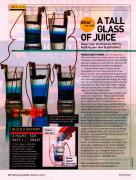| A Tall Glass of JuicePower your stuff like it's 1899 by building your own liquid battery |
| |
|
| |
1. Pour copper sulfate (the blue granules) over a copper electrode in a glass.
2. Fill it with distilled water.
3. Add a crowa^\200\231s-foot-zinc electrode, and short-circuit the battery for 24 hours to kick-start the battery reaction.
4. Connect to the device of your choice. Yields one volt.
People used to make a lot of things at home. They churned their own butter, cooked food without microwaves, and knitted pairs of socks. Some hundred years ago, people even made their own electricity: DIY batteries powered their doorbells and telegraphs.
Today, batteries meant for heavy use are rechargeA^\[DiscretionaryHyphen]able. But how do you get power when there is no grid? Early batteries were designed to be a^\200\234renewed,a^\200\235 which meant replacing or replenishing their chemicals to give them new energy. Youa^\200\231d top them off with then-common general-store items like crowa^\200\231s-foot zinc, blue vitriol, black oxide of manganese, and caustic soda. (The latter is still available in stores, but now ita^\200\231s called Drano.)
One particularly photogenic type of battery was known as a a^\200\234gravity cell,a^\200\235 because gravity is what held it together. Typically used to power telephone and telegraph circuits, it consisted of a solution of blue vitriol (known these days as copper sulfate and sold in garden centers for pond treatment) on the bottom and a layer of zinc sulfate on top, kept separate only by their slightly different densities.
At the top, the electrode gives off zinc ions, while at the bottom, copper sulfate is reduced into copper metal. Together these complementary reactions produce just over one volt; string five batteries in series, and you get enough power to run a flashlight or charge an iPod. Any movement disturbs the delicate layers, ruining the battery, but if youa^\200\231re careful, you can drop in new crystals of blue vitriol as needed, and the battery will run for years.
There is even talk of running electric cars on zinc-air or aluminum-air batteries. Like gravity cells, these types of batteries can be renewed instantly by dumping in more zinc or aluminum, rather than plugging them into a charger for hours on enda^\200'which should make for much shorter lines at the corner battery station.
Scan of printed version:
 |
| |
|
| |
|
| |

LIQUID LIGHTING: A chain of five homemade gravity-cell batteries powers a string of LEDs.

Granulated copper sulfate is added to a glass of water holding the two electrodes.
Photo Credits:
Mike Walker
Mike Walker
|
|